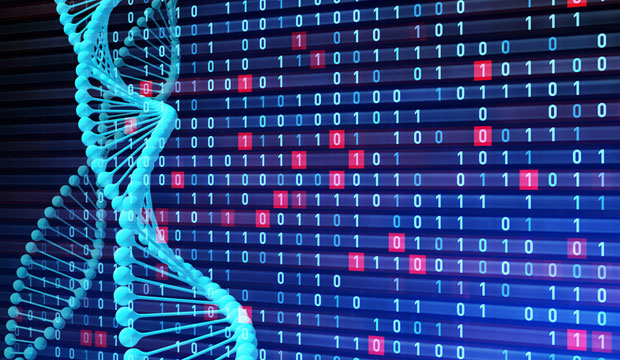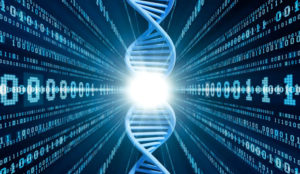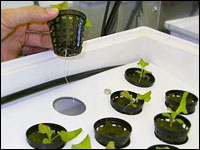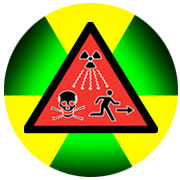The shape of the Genome poemis scattered stars; a twinkling netof orchestrated switchesMolecules drafted through millennia,coagulating endless dreams of water;Chemistry’s infinite creative palettesampling light and elementsdandelion suns, beheaded as aristocrats,lion-shorn — still imagine symbiotic airlifting their lost materials,on round, star-hair wings.
— “The Human Genome: Poems on the Book of Life” by Gillian K. Ferguson
Vaccines grown in heads of lettuce … auto and aircraft tire rubber made from dandelion taproot sap … designer pharmaceutical “biologics” to fight autoimmune diseases like MS, diabetes … neoteric industrial enzymes, artificial XNA polymers, anaerobic digestion biofuels … . In their journey from DNA to protein, each of these noteworthy products shared something in common: They were the result of the use of recombinant DNA (rDNA) molecules in a process called “DNA printing” — aka “artificial gene sequencing, synthesis and protein production.”
Each product began as a digital “gene of interest” in a genomic database on the cloud-based Internet of DNA, represented in computer program code specifying the precise order of four chemical building blocks — the “nucleobases” A,T, C and G ([A]denine, [T]hymine, [C]ytosine and [G]uanine) — along a segment of DNA that would be used to turn that sequential computer code into actual genetic material.
Each ended up as a “protein of interest” organic molecule in a laboratory machine called a “synthesizer,” developed for use in protein production, drug discovery, clinical diagnostics and the manufacture of useful commercial products.
New Formula
In the DNA printing process, plant and animal genomes are sequenced in computerized sequencers using gel electrophoresis technology, translated from genetic code into computer code, uploaded to cloud databases (Internet of DNA) for storage and analysis, then designed in silico using CAD software.
Laboratories then download digital “gene of interest” DNA segments for chemical assembly of an artificial DNA strand that is fused with a bacterial plasmid (a replicating non-chromosomal DNA segment) to become an rDNA molecule cloning and expression vector (carrying agent).
The rDNA is inserted into a host E. coli bacterium that reproduces exponentially through binary fission to amplify the original downloaded genetic fragment as individual DNA clones in a colony capable of production of large quantities of the original target gene to manufacture “protein of interest” products encoded by that gene.
DNA printing is based on the natural flow of genetic information in a cell from DNA through RNA to amino acids to proteins, from gene to protein, genome to proteome, genomics to proteomics. DNA, life’s foundation blueprint, makes up genes, the instructions for making proteins — the complex molecules that do most of the work in living organisms.
“DNA makes RNA makes proteins make Life.”
That simple formula, which has worked well for life on Earth for at least half a billion years, very recently has turned into a trillion-dollar modern global industry based on an updated formula: “People make DNA.”
DNA, or deoxyribonucleic acid, is the macromolecule that is the main component of the gene-carrying chromosomes in every cell nucleus — the enzymatic substance that contains the genetic instruction guide for the development and functioning of all living things. It determines inheritance, codes for proteins, and makes up the enigmatic core around which our behavior, desires, fears and health, to a large extent, revolve.
“The greatest single achievement of nature to date was surely the invention of the molecule DNA,” wrote the late scientist and author Lewis Thomas in his book The Lives of a Cell. “All of today’s DNA, strung through all the cells of the Earth, is simply an extension and elaboration of the first molecule.”
Grand as it may be, DNA is basically an organic chemical molecule made from atoms of carbon, hydrogen, nitrogen, oxygen and phosphorous. Yet from such commonplace ingredients arise the essential building blocks of our physical identity.
DNA has enabled us to manipulate its very substance in order to create forms of life Nature never conceived. This profound development is due to rDNA technology and recombinant protein production in the DNA printing process.
Recombinant DNA and Proteins
rDNA entails the way in which genetic material from one organism artificially is introduced into the genome of another organism, and then replicated and expressed by that other organism. Genes inserted into foreign host organisms produce new genetic combinations that are of value to science, medicine, agriculture and numerous (if not all) other fields.
In the time since the mapping of the human genome was completed in 2003, DNA printing, rDNA technology and recombinant protein production have become a monster business worldwide. Genes make the proteins that make life, but mankind uses both genes and the proteins it creates to make money.
The global rDNA technology market size, estimated at US$497.7 billion in 2016, is expected to reach $844.6 billion by 2025 (and probably much more, much sooner), according reports Grand View Research released last year.
rDNA is possible because DNA molecules from all organisms share the same chemical structure, and differ only in the nucleotide sequences within that identical overall structure. Proteins that can result from rDNA expression within living cells are termed “recombinant proteins.”
A recombinant protein is an organic molecule that has been encoded by a cloned rDNA gene. Recombinant protein results from a manipulated form of protein generated in various ways to produce large quantities of special proteins, modify gene sequences, and manufacture useful commercial products such as enzymes, growth factors, hormones, antibodies, vaccines and much more.
The global recombinant protein market was valued at $347.2 million in 2016 and is expected to surpass $593.4 million by 2025 globally, according to Coherent Market Insights.
Many “biologics” — medicines or drugs made of large, complex mixtures of molecules from living organisms and including tissues, genes, allergens, blood components and more — result from recombinant protein applications and work by targeting particular chemicals or cells involved in the body’s immune system response. Biologics require FDA approval for commercial use.
Some of the more well known rDNA-derived biologics are used to treat rheumatoid arthritis and other autoimmune ailments like psoriasis and Crohn’s disease. These biologics include Humira (adalimumab), Remicade (infliximab), Rituxan (rituximab) and Enbrel (etanercept). TV commercials promoting these products have been airing incessantly of late, targeting an aging, often ill, population.
The biologics market was valued at $254.9 billion in 2017 and projected it to reach $580.5 billion by 2026 in a Research and Markets report published this spring.
The numbers mentioned above no doubt overlap, but the cash certainly flows in the hundreds of billions of dollars range because rDNA technology and recombinant protein composition have led to a wealth of exotic new products from entire new industries pouring out of clinical, R&D and production laboratories into the global marketplace.
None of it would be possible without sequencing of the human genome, which made DNA printing possible.
3D Printing
The concept of DNA printing borrows from 3D printing, an additive manufacturing process using computer control to create three-dimensional objects of all kinds (e.g., tools, toys, jewelry, sculptures). Today, there are even 3D-printed firearms. The 5,300-year-old frozen European mummy tzi the Iceman has been rendered as a 3D-printed plastic and resin model.
DNA printing is a 3D additive process, because each chromosome consists of two very large molecules of DNA wound around each other (each strand is a separate molecule).
The artificial DNA manufacturing process is “additive” because DNA printing specifically involves using automated laboratory workstations to synthesize (create and build), assemble, and churn out tailored stretches of artificial DNA.
Can DNA be “printed”? Yes and no.
In sequencing DNA, DNA’s four physical chemical nucleobases — adenine, thymine, cytosine and guanine — can be represented as the letters A, T, C and G for the purposes of translating their sequential order in genes and the genome. These letters can be stored in computer memory, communicated in electronic form, and even printed out as text if necessary.
In synthesizing (building up) DNA into an artificial gene, that gene is assembled as chemicals on a physical structure and then cloned (copied) — not “printed” in the sense of producing written materials.
The resulting genetic materials are used to develop products and investigate technical issues across many life science fields, such as cancer immunotherapy, neuroscience, virology and vaccine design, therapeutic antibody engineering, plant biology research, biochemistry, genome analysis and manipulation, and more.
Much of the momentum stems from recent advances in once arcane but now increasingly mainstream state-of-the-art techniques and technologies in areas like genetic engineering, industrial biotechnology, synthetic biology, computational biology, biological computing, in silico predictive modelling, cybergenomics and bioinformatics.
The Internet of DNA — a global network of databases connected in the cloud on a peer-to-peer communications model — consists of a worldwide array of data centers full of servers containing centillions of bytes of animal, plant and microbial genomic information.
Genome – ‘Book of Life’
Genomes are the full sets of chromosomes within cells containing all of an organism’s genes and DNA (while a proteome is the full complement of proteins that occur within a cell, tissue or entire organism).
The human genome is our “book of life.” In each cell there are 3 billion base pairs, the “letters” of DNA that spell out the recipe of a person. The human genome is the complete set of nucleic acid (DNA/RNA) sequences for humans, encoded within the 23 chromosome pairs in cell nuclei (and in a small DNA molecule found within individual mitochondria outside the cell nucleus).
The human genome contains around 20,000 genes, the stretches of DNA that encode proteins. A coding gene consists of enough DNA to code for one protein, but these genes account for only about 1.2 percent of the total genome, called the “exome.” The other 98.8 percent consists of what’s known as “noncoding” DNA molecules.
Non-protein genomic coding regions not related directly to making proteins once were referred to as “junk” DNA. Now they are thought of more as a completely dense jungle of mysterious stuff. The ENCODE group, a project of the U.S. National Human Genome Research Institute (NHGRI), produced a stunning inventory of previously hidden switches, signals and signposts embedded like runes throughout the entire length of human DNA.
Here’s where the genome fits into living biological systems:
Organism > tissue > cells > cell nucleus > genome > chromosomes > genes > DNA/RNA > nucleotides (DNA’s fundamental building blocks) > nucleobase pairs (A-T/C-G). (Note: Mitochondria — energy generators outside cell nuclei — have their own DNA and are another topic.)
Nucleotides are the backbone sides of DNA’s double-helix spiral ladder, and these sides are linked together by four different types of paired chemical ladder “steps”: adenine-thymine and cytosine-guanine (also in reverse order — T/A-G/C).
The first full DNA genome to be mapped and sequenced was that of bacteriophage phiX174 in 1977. The first plant genome to be sequenced was Arabidopsis thaliana, a wild member of the mustard family, in 2000. The Human Genome Project (HGP), which involved sequencing of the 3 billion base pairs that make up the human genome, was completed in April 2003.
Sequencing led to synthesis, and in 2010, American biotechnologist, biochemist, geneticist and businessman J. Craig Venter, along with colleagues from The Institute for Genomic Research (TIGR) and the J. Craig Venter Institute (JCVI), were the first to transfect a cell with a synthetic chromosome, using entirely synthesized DNA to create a self-replicating microbe, dubbed Mycoplasma laboratorium.





















































